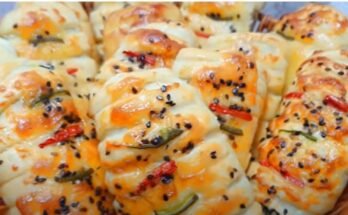As the holy month of Ramadan descends upon the bustling city of Lahore, the air becomes filled with a sense of spirituality, community, and of course, the enticing aromas of traditional Pakistani cuisine. Among the many delectable treats that grace the iftar tables across the city, one dessert stands out for its vibrant appearance and delightful taste – Malai Khaja, also known as Khoya Malai. In this blog post, we’ll explore how to create this beloved sweet, perfect for breaking your fast during Ramadan in Lahore.
The Significance of Malai Khaja During Ramadan
In Lahore, Ramadan is a time of reflection, prayer, and coming together with family and friends. It’s also a period when culinary traditions shine, with households and bazaars alike bustling with activity as people prepare for iftar, the meal to break the day’s fast. Malai Khaja holds a special place in these iftar spreads, offering a sweet indulgence that’s both satisfying and energy-boosting after a long day of fasting.
Ingredients for Your Ramadan Malai Khaja
Before we begin our culinary journey, let’s gather the ingredients you’ll need to create this Lahori Ramadan favorite:
- 2.5 kg all-purpose flour (maida)
- 1 kg water
- 250g desi ghee
- 1/2 tsp baking powder
- Food coloring (green and red, commonly used in Lahori sweets)
- Khoya (available fresh in Lahore’s markets during Ramadan)
- Green cardamom pods (a staple in Pakistani desserts)
- Sugar and water for syrup
Preparing the Dough: A Lahori Technique
- In a large mixing bowl, combine 1 kg of water with 250g of desi ghee. This mixture is key to achieving the flaky layers that Lahori Malai Khaja is famous for.
- Gradually add 2.5 kg of all-purpose flour to the water-ghee mixture. Knead the dough until it reaches a slightly firm consistency, reminiscent of the texture used in other popular Lahori pastries.
- Cover the dough with a damp cloth, a common practice in Lahore’s humid Ramadan weather, and let it rest for 15-20 minutes.
Creating Vibrant Layers: A Nod to Lahore’s Colorful Culture
- Divide the dough into three portions. Leave one portion plain, representing the simplicity of Ramadan, and color the other two with green and red food coloring, reflecting the vibrancy of Lahore’s festive spirit.
- Roll each portion of dough into a thin sheet, using dry flour to prevent sticking – a technique passed down through generations of Lahori bakers.
- Layer the colored sheets on top of the plain dough, using a light brush of water between layers, symbolizing the coming together of communities during Ramadan.
Crafting the Layered Roll: A Lahori Art Form
- Spread a thin layer of the prepared desi ghee (mixed with a pinch of baking powder) over the entire surface, a step that contributes to the rich flavor Lahoris love.
- Carefully roll the layered dough into a tight cylinder, a process that requires the skill and patience cultivated during the long Ramadan days.
- Cut the roll into two parts and gently stretch each part, much like how the spirit stretches and grows during the holy month.
Shaping and Filling: The Heart of Lahori Malai Khaja
- Cut the stretched dough rolls into small, equal-sized pieces (about 70-80g each), similar to the portions served at Lahore’s famous iftar gatherings.
- Prepare the khoya filling by mixing fresh khoya from Lahore’s markets with crushed green cardamom seeds, creating a fragrance that’s unmistakably Ramadan in Lahore.
- Fill and shape each piece of dough, arranging the colors in a crisscross pattern that reflects the intertwining of tradition and modernity in Lahore’s Ramadan celebrations.
Frying to Perfection: A Lahori Iftar Ritual
- Heat desi ghee in a large karahi, a cooking vessel commonly used in Lahori kitchens.
- Fry the Malai Khaja pieces slowly over medium-low heat, much like the gradual spiritual awakening experienced during Ramadan.
- The slow frying process, taking about 15-20 minutes, fills the kitchen with an aroma that signals to fasting family members that iftar is near.
The Sweet Finale: Lahori-Style Sugar Syrup
While the Malai Khaja cool, prepare a sugar syrup that will add the final touch of sweetness:
- Combine sugar and water in the ratio preferred by Lahori taste buds (typically 2:1).
- Heat the mixture to achieve a one-string consistency, a skill perfected by Lahore’s seasoned sweet-makers.
Serving Your Ramadan Malai Khaja
- Drizzle the warm sugar syrup over each piece of Malai Khaja, adding a glistening finish that catches the light of the iftar table.
- Serve your Malai Khaja alongside other Lahori Ramadan favorites like fruit chaat, dahi baray, and of course, a steaming cup of Kashmiri chai.
Why Malai Khaja is Perfect for Ramadan in Lahore
- Energy-Boosting: The combination of ghee, khoya, and sugar provides a quick energy boost, ideal for breaking the fast.
- Community Spirit: The process of making Malai Khaja can be a family activity, bringing loved ones together during Ramadan.
- Customizable: You can adjust the sweetness and flavors to suit your family’s preferences, a common practice in Lahori households.
- Make-Ahead Friendly: Prepare them in advance to ease the daily iftar rush, a boon for busy Lahori families during Ramadan.
- Perfect for Sharing: These sweets are ideal for sharing with neighbors and at community iftars, embodying the spirit of generosity during Ramadan.
Tips for Ramadan Success
- Prepare the dough in the cooler morning hours to beat Lahore’s Ramadan heat.
- Involve family members in the process, turning it into a bonding activity during the holy month.
- Make extra to share with neighbors or donate to those in need, a common Ramadan practice in Lahore.
Conclusion: A Taste of Ramadan in Lahore
Creating Malai Khaja at home during Ramadan in Lahore is more than just cooking; it’s participating in a rich cultural tradition. As you prepare this dessert, you’re not only crafting a delicious treat but also connecting with the spirit of Ramadan and the vibrant food culture of Lahore.
So, this Ramadan, as the sun sets over the Badshahi Mosque and the call to Maghrib prayer echoes through the streets of Lahore, gather your loved ones and treat them to homemade Malai Khaja. It’s more than just a dessert – it’s a celebration of faith, family, and the flavors that make Ramadan in Lahore truly special.
Remember to share your Malai Khaja experiences in the comments below, and from all of us in Lahore, Ramadan Kareem!



